
Decoding Radiation Risk: A Simplified Guide to Bayesian Analysis in Cytogenetic Dosimetry
"Understand how a streamlined Bayesian method enhances accuracy in assessing radiation exposure, crucial for health and safety in nuclear environments."
Cytogenetic biological dosimetry plays a vital role in estimating radiation doses by analyzing biomarkers like dicentric chromosomes in human lymphocytes. This is especially critical after accidental exposures, where quickly and accurately determining the absorbed dose is paramount for effective medical response and long-term health monitoring.
When dealing with mixed radiation fields, like those involving both neutron and gamma radiation (n+γ), the complexity increases significantly. Each type of radiation has a different Relative Biological Effectiveness (RBE), meaning they cause different levels of biological damage for the same absorbed dose. Precisely estimating the individual components of the mixed dose is crucial, not just the total dose.
Traditional methods, such as iterative processes, often require precise knowledge of the ratio between neutron and gamma doses. However, in real-world scenarios, this information might not be readily available. This is where Bayesian statistical methods come into play, offering a robust alternative that can incorporate prior knowledge and uncertainties to provide more reliable dose estimations. This article explores a simplified Bayesian approach developed for application in cytogenetic biological dosimetry, particularly within mixed n+γ radiation fields, offering a practical tool for enhancing radiation safety and response efforts.
Bayesian Analysis: Simplifying Dose Estimation in Mixed Radiation Fields

The core challenge in accurately assessing radiation doses from mixed fields lies in the different biological impacts of each radiation type. Traditionally, methods rely on knowing the precise ratio (ρ) of neutron dose (Dn) to gamma dose (Dy). However, when this ratio is uncertain or unknown, these methods falter. Bayesian analysis provides a powerful alternative by incorporating prior knowledge about the likely range of this ratio, even if it's not precisely known.
- Focusing the prior distribution solely on the dose ratio parameter (ρ or θ).
- Treating the parameters of the dose-response curves as fixed values, based on existing calibration data.
- This simplification significantly reduces the computational burden while still providing accurate dose estimations.
Improving Radiation Safety with Streamlined Bayesian Methods
The simplified Bayesian method represents a significant advancement in the field of cytogenetic biological dosimetry, offering a more practical and efficient approach to dose estimation in mixed radiation fields. By streamlining the calculations and focusing on the most critical parameters, this method makes it easier to accurately assess radiation exposure, even when complete information is lacking.
The computational program developed as part of this research provides a user-friendly tool for implementing the simplified Bayesian method, making it accessible to a wider range of users. This program, along with the described methodology, can significantly enhance radiation safety and response efforts in various settings, from nuclear research facilities to emergency response scenarios.
Future research will focus on extending this approach to multi-field irradiation scenarios, which involve more than two types of radiation. This will be particularly relevant in addressing the radiation protection challenges associated with long-duration space missions and other complex radiation environments.
